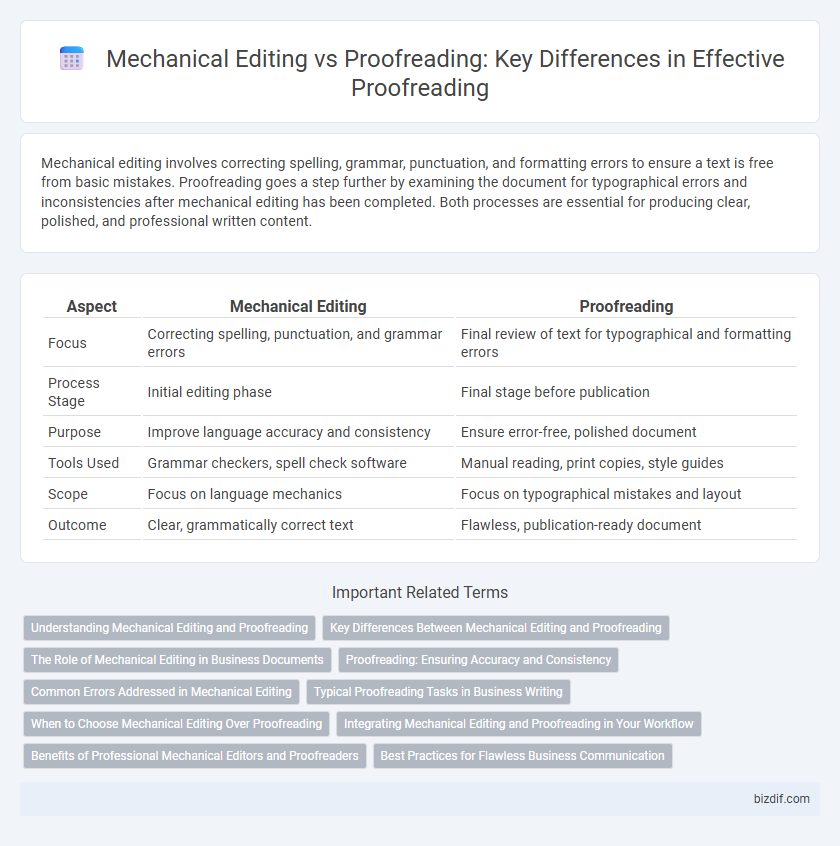Mechanical editing involves correcting spelling, grammar, punctuation, and formatting errors to ensure a text is free from basic mistakes. Proofreading goes a step further by examining the document for typographical errors and inconsistencies after mechanical editing has been completed. Both processes are essential for producing clear, polished, and professional written content.
Table of Comparison
| Aspect | Mechanical Editing | Proofreading |
|---|---|---|
| Focus | Correcting spelling, punctuation, and grammar errors | Final review of text for typographical and formatting errors |
| Process Stage | Initial editing phase | Final stage before publication |
| Purpose | Improve language accuracy and consistency | Ensure error-free, polished document |
| Tools Used | Grammar checkers, spell check software | Manual reading, print copies, style guides |
| Scope | Focus on language mechanics | Focus on typographical mistakes and layout |
| Outcome | Clear, grammatically correct text | Flawless, publication-ready document |
Understanding Mechanical Editing and Proofreading
Mechanical editing involves correcting surface errors such as grammar, spelling, punctuation, and formatting to ensure the text adheres to style guidelines. Proofreading is the final stage of the editing process focused on detecting minor mistakes like typos and inconsistencies that affect readability. Both processes are essential for producing polished, error-free written content that meets professional standards.
Key Differences Between Mechanical Editing and Proofreading
Mechanical editing involves correcting grammar, punctuation, spelling, and syntax errors to ensure the text adheres to language conventions. Proofreading focuses on the final review of the text to catch surface-level mistakes such as typos, formatting inconsistencies, and missing words before publication. The key difference lies in mechanical editing being a deeper, more comprehensive process, while proofreading is a precise, final quality check.
The Role of Mechanical Editing in Business Documents
Mechanical editing plays a crucial role in business documents by ensuring accuracy in grammar, punctuation, spelling, and formatting, which enhances professionalism and clarity. This process helps eliminate errors that could lead to misunderstandings or damage a company's credibility. By refining the technical aspects of text, mechanical editing supports effective communication and strengthens the overall impact of business correspondence.
Proofreading: Ensuring Accuracy and Consistency
Proofreading plays a critical role in ensuring accuracy and consistency by meticulously identifying and correcting surface errors in spelling, punctuation, grammar, and formatting. Unlike mechanical editing, which involves more extensive structural and stylistic changes, proofreading serves as the final quality control step to guarantee a polished and error-free document. Consistent application of style guides and attention to detail during proofreading enhances the overall readability and professional presentation of written content.
Common Errors Addressed in Mechanical Editing
Mechanical editing targets common errors such as punctuation mistakes, spelling inaccuracies, and grammatical inconsistencies that disrupt the clarity of a text. It ensures proper sentence structure, corrects verb tense usage, and addresses issues like subject-verb agreement and misplaced modifiers. This process refines the technical accuracy of a document, enhancing readability and professional presentation.
Typical Proofreading Tasks in Business Writing
Typical proofreading tasks in business writing include checking grammar, punctuation, spelling, and formatting errors to ensure clarity and professionalism. Unlike mechanical editing, which may involve rephrasing and structural changes, proofreading focuses solely on surface-level corrections without altering the author's original intent. This process guarantees polished documents that maintain accuracy and brand consistency across reports, emails, and official communications.
When to Choose Mechanical Editing Over Proofreading
Mechanical editing is ideal when a text requires correction of grammar, punctuation, spelling, and formatting errors to ensure linguistic accuracy. This process is crucial for drafts that contain numerous structural mistakes or inconsistent style elements needing systematic revision. Opt for mechanical editing over proofreading when the primary goal is to enhance text mechanics rather than just catch occasional typos or minor errors.
Integrating Mechanical Editing and Proofreading in Your Workflow
Integrating mechanical editing and proofreading enhances the accuracy and clarity of your documents by combining comprehensive grammar checks with final error detection. Mechanical editing targets structural elements such as punctuation, grammar, and syntax to establish a polished foundation, while proofreading focuses on identifying typographical errors and inconsistencies before publication. Streamlining both processes within a single workflow improves efficiency and ensures a higher-quality, error-free final product.
Benefits of Professional Mechanical Editors and Proofreaders
Professional mechanical editors and proofreaders significantly enhance text accuracy by meticulously correcting grammar, punctuation, and spelling errors, ensuring clarity and coherence. Their expertise in maintaining consistent formatting and style adherence optimizes document professionalism and readability. This precision not only elevates the quality of academic, technical, and business documents but also strengthens the credibility and impact of the content.
Best Practices for Flawless Business Communication
Mechanical editing focuses on correcting grammar, punctuation, and spelling errors to ensure clarity and professionalism in business documents. Proofreading involves a final review to catch overlooked typos, formatting inconsistencies, and minor mistakes that affect readability. Implementing both practices guarantees flawless business communication by enhancing accuracy and maintaining a consistent tone across all written materials.
mechanical editing vs proofreading Infographic

 bizdif.com
bizdif.com